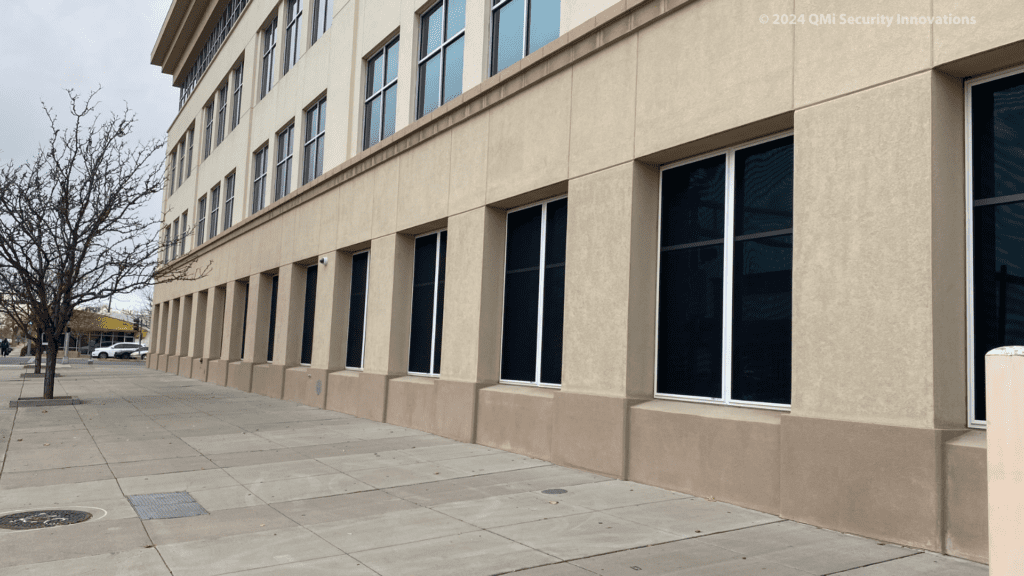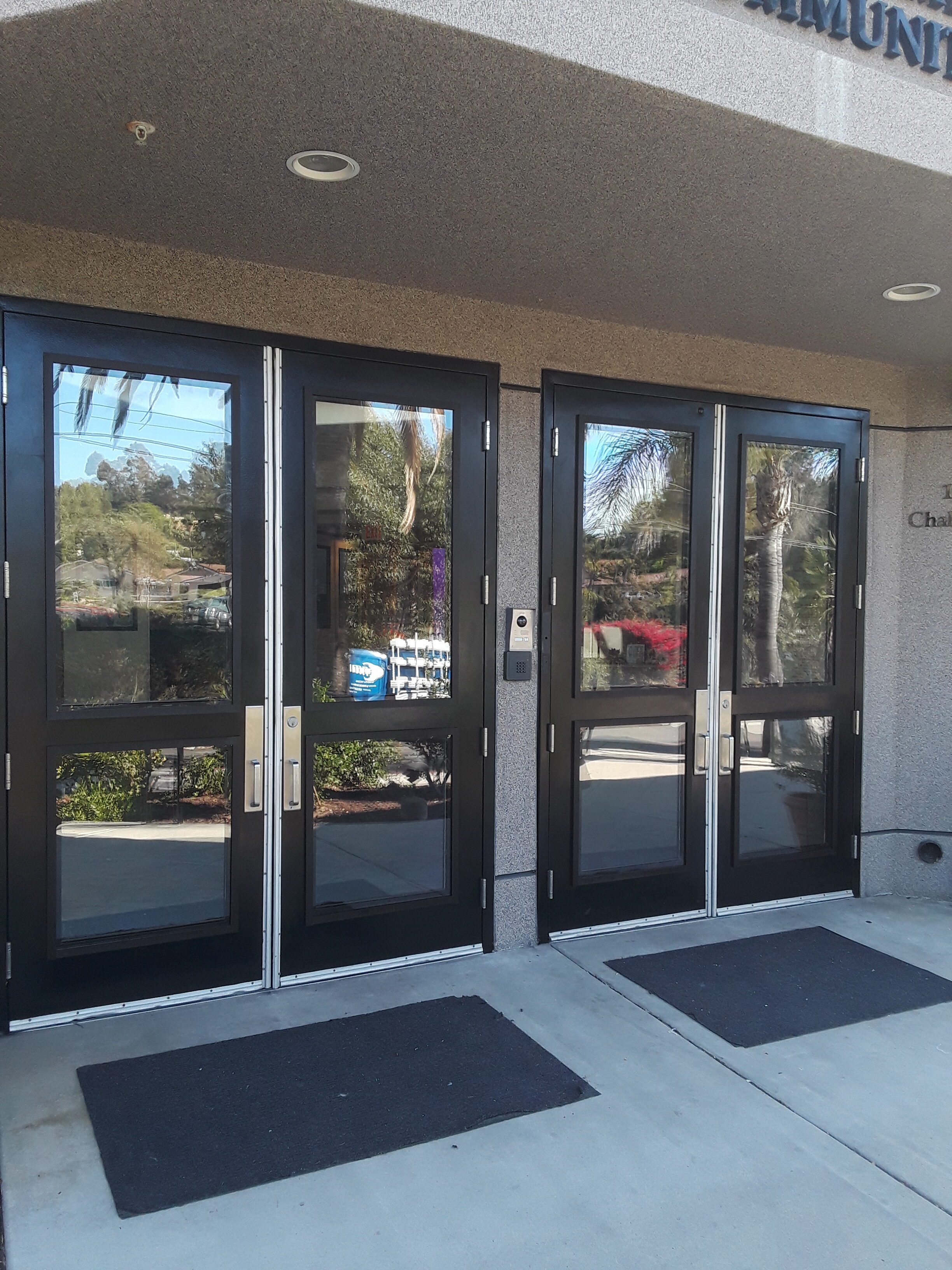Government buildings play a critical role in maintaining public services, law enforcement, and administrative functions. Given their significance, these structures are often the target of break-ins, vandalism, and civil unrest.
Without adequate door and window security, government facilities risk unauthorized access, operational disruptions, and potential harm to personnel and assets.
When it comes to securing government building doors against forced entry and civil unrest, two solutions stand out:
1. Forced entry and ballistic-grade security glazing (Riot Glass) for glass entryway doors.
2. High-security stainless steel screens to protect windows and vents from vandalism and attack.
These solutions provide the necessary strength to withstand forced entry attempts, ensuring that government buildings remain secure in high-risk situations. Let’s explore each in detail.
The Importance of Securing Government Building Doors
Government facilities are uniquely vulnerable to security threats, including:
- Civil Unrest and Riots: Protests and demonstrations can escalate into violent situations where individuals attempt to breach a building’s perimeter.
- Targeted Attacks: Government buildings are high-profile targets for politically motivated threats, terrorist attacks, or criminal activities.
- Break-ins and Vandalism: Unsecured doors can invite unauthorized access, theft, and property damage.
To mitigate these risks, government agencies must invest in reinforced entry and security screen solutions that can withstand sustained attacks, unauthorized access attempts, and high-force impacts.

Solution 1: Forced Entry and Ballistic-Grade Security Glazing for Glass Entryway Doors
Many government buildings feature glass entryway doors for aesthetic and accessibility reasons.
While visually appealing, standard glass government building doors provide little resistance to forced entry attempts.
Attackers using hammers, crowbars, or even firearms can quickly break through standard tempered glass, compromising the building’s security.
What Is Riot Glass Security Glazing?
Riot Glass is an advanced forced-entry and ballistic-grade security glazing solution designed to reinforce glass doors and windows.
Unlike traditional glass, Riot Glass resists shattering and can withstand sustained attacks with blunt objects, firearms, and other tools commonly used in break-ins.
Key Features of Riot Glass for Government Building Doors:
- Forced Entry Resistance: Riot Glass remains intact even after repeated strikes with blunt objects, preventing intruders from gaining quick access.
- Ballistic Protection: Some Riot Glass options can stop bullets, offering an extra layer of security in the event of an armed attack.
- Shatter Resistance: Unlike standard glass that shatters on impact, Riot Glass remains in place, keeping the entryway secure.
- Clear and Tinted Options: Government facilities can maintain the appearance of traditional glass or add tinting to increase privacy.
How Riot Glass Improves Security During Civil Unrest
During riots or protests, glass doors are a primary target for vandals and intruders. Without reinforcement, a few well-placed strikes can break through traditional glass, granting access to unauthorized individuals.
Riot Glass prevents quick breaches, delaying, deterring, and in many cases, completely preventing forced entry attempts. Even if a building comes under sustained attack, Riot Glass ensures that government personnel and sensitive materials remain secure until law enforcement or security teams can respond.
Installation and Retrofitting
One of the major advantages of Riot Glass is that it can be retrofitted onto many existing glass entry doors without requiring a full door replacement. This makes it a very cost-effective solution for upgrading security without extensive renovations.

Solution 2: Stainless-Steel Screens for Windows and Vents
While glass entryway doors are a major concern, windows and vents are often the weakest points of a government building’s security. Attackers frequently target these areas because they tend to be weaker with less surveillance and security coverage.
What Are Stainless-Steel Window Security Screens?
Stainless-steel window security screens are created to discreetly blend in with the design of your building, creating robust defense while maintaining visual appeal.
Key Features of Stainless-Steel Window Security Screens for Government Facilities:
- Made of Resilient Stainless-Steel Mesh: Offering clear exterior views without compromising security.
- Aluminum Framing: This attaches easily to your structure and maintains its integrity under sustained attack.
- Customizable Colors: Our standard screen frames are white, bronze, or beige. Custom frame colors are available at an additional cost and extended lead time.
- Egress vs Fixed Screens: Unlike a fixed screen, egress screens have a continuous hinge on one side, and a panic bar on the other, allowing for emergency exits.
Why Are These Essential for Government Buildings?
Government buildings often have multiple access points, and not all points receive the same level of security attention. While main entrances may have high security, windows and vents can become an easy entry point for intruders if left unprotected.
Security screens eliminate these vulnerabilities, ensuring that all potential entry points are fortified against break-ins.
How These Screens Perform During Civil Unrest
During civil unrest, rioters and criminals often look for the fastest way to gain entry into a building.
Our security screens prevent unauthorized access by resisting sustained attacks, delaying intruders long enough for security personnel or law enforcement to respond.
Implementing a Comprehensive Government Building Door Security Strategy
While upgrading government building doors with Riot Glass and high-security metal doors is essential, a comprehensive security strategy should also include:
- Reinforced Locking Mechanisms: Heavy-duty deadbolts and electronic access control systems further improve door security.
- Surveillance and Monitoring: Installing security cameras and motion detectors near entry and exit points provides real-time monitoring of threats.
- Security Personnel Training: Staff should be trained on emergency protocols and door security procedures to respond effectively in a crisis.
Conclusion: The Best Solutions for Securing Government Building Doors
Government facilities face ongoing security challenges, making it critical to reinforce vulnerable entry points against forced entry and civil unrest.
Using Riot Glass and QMi’s innovative solutions, government agencies can ensure their buildings remain protected in high-risk situations. These security solutions provide long-lasting durability, resistance against common forced-entry tactics, and peace of mind for those responsible for safeguarding critical infrastructure.
Investing in these proven security measures is essential for maintaining the integrity of government facilities, preventing unauthorized access, and ensuring the safety of personnel and assets. Contact QMi today to get started.

